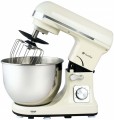Add to comparison |  |  |
|---|---|---|
| TRISTAR MX-4817 white | Gemlux GL-SM5.5CR ivory | |
| Compare prices 3 | Outdated Product | |
| TOP sellers | ||
| Type | planetary mixer | planetary mixer |
Equipment | ||
| Nozzles | main bowl | main bowl |
| Accessories | whisk beater for mixing nozzle / dough hook | whisk beater for mixing nozzle / dough hook |
Characteristics | ||
| Bowl capacity | 5 L | 5 L |
| Power | 1200 W | 1000 W |
| Number of speeds | 6 | 6 |
| Pulse mode | ||
General | ||
| Main bowl material | metal | metal |
| Body material | plastic | plastic |
| Dimensions (LxWxH) | 43х38х30 cm | |
| Weight | 4.5 kg | |
| Color | ||
| Added to E-Catalog | september 2019 | april 2018 |